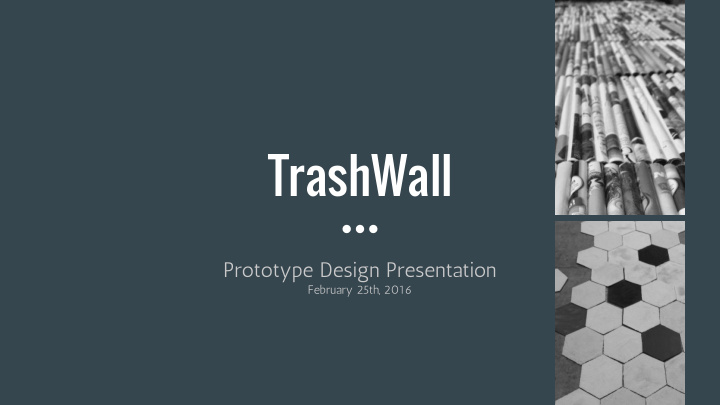



TrashWall Prototype Design Presentation February 25th, 2016
Background People with lower income typically live in the least energy efficient homes ● For some, heating and cooling their homes is a major burden ● As college students, we can relate to the struggling to pay bills ● We wanted to address this problem and began looking towards a solution ● that could help people living in energy inefficient homes.
Previous Work Over the past year and a half, groups of architecture and mechanical ● engineering students have worked on this project. Our idea has been to build an extra insulation layer to be placed in a home ● that will help keep the house warm or cool Areas of focus: ● Low cost (goal of less than $0.10/square foot) ○ Good insulation ability ○ Easy to manufacture/install ○ Aesthetically appealing ○ Safe to use in a home ○
Current Work In the process of merging architectural and engineering designs together. ● Engineering designs focus mainly on structure, thermal resistivity, ● manufacturability, and fire safety. Architecture designs focus more on aesthetics and exploring different ● available recyclables uses. Architecture students have came up with a “skin” which is placed on the ● interior of the Trash Wall. This “skin” is the only visible part of the Trash Wall when installed in a home.
Our Vision To inspire people to build these walls in a way that suits their needs/wants ● To give people a good starting point on how to build a Trash Wall and ● different options for them to pursue. Change/transform people’s thoughts about recyclables and trash ● Inform people of the possibilities of recycled materials to improve their lives ● and also reduce air pollution/greenhouse gases We hope that through this project, we not only provide practical solutions to ● a very real problem, but also that we inspire people to look at trash differently, and to feel empowered to engineer solutions.
Project Overview The wall will be composed of two parts: Structure + Skin ● We’ve compiled several prototypes ● The goal is to give people ideas about how trash could be used, a recipe, ● etc.
Structure 1: Cardboard Tubes Size: 4’x8’ Time to Construct: - Boxes: 5 mins each (32 total) - Tubes: 3 mins each (45 total) Pros: no glue required, modular, ease of construction and assembly, no toxic fume when ignited Cons: Prone to offset error, limited accessibility of some material, flammable
Structure Construction Crease + Fold box Cut slits at the corners for tube supports Cardboard tubes locks multiple units together
Structure 2: Plastic Bottles Construction time ● 3 hours and 56 minutes for 36 boxes ○ Pros ● Recycled materials ○ Sturdy ○ Cons ● ○ Toxic fumes from burning plastic Bottles should be lined up correctly to avoid bending ○
Bottle Connection
Skin Group 1 Pixlr Wall
Materiality Components: Magazine Pages, Cardboard, Flour Glue. Application Method: Roll magazine pages (landscape direction), coat with glue, stick on cardboard
Skin Application
Prototypes Panel Size 1’x1’ Aluminum Cans Vertical magazine pattern Soda Labels Bottle Caps Cardboard pattern 1 Cardboard pattern 2 Checkered magazine pattern Rolled magazine pattern Egg Carton
Group 1: Prototype Data Material Manufacture Time Burn Time Cost Pros Cons (min. per panel) Magazine 10-12 $0.00 easily accessible material; lightweight, Flammable colorful material flexible patterns Corrugated Cardboard 15-20 $0.00 easily accessible abundant material; Moderate warping lightweight flammable Aluminum Cans 20 $0.00 fire resistant Difficult to cut colorful material sharp edges Plastic Bottle Labels 15 $0.00 easily accessible material; lightweight Toxic fumes provides various patterns/colors Plastic Bottle Caps 7 $0.00 easily accessible material; lightweight Toxic fumes colorful material Egg Carton 5 $0.00 easily accessible Flammable one color
PIXLR WALL: Affordable Personal Meaningful Deconstructable
Skin Group 2 Papercrete
Materiality Components: Papercrete mixture, Cardboard to apply paste to. Ingredients: 60% paper pulp, 20% cement, 20% water (by weight) Method of mixture and application: Mixing all ingredients into a container. Applies onto cardboard corrugation directly by spreading paste like mixture. thickness of mixture is thinner than 1/8”
Data Mixture preparation time: 5 - 8 mins application of the mixture to surface: 8 - 10 mins Drying time: 5 - 6 hours Flame resistance time : 15 - 20 mins Cost ( Skin) : $ 0 . 625 / sf
Construct Diagram
Prototype Variation
Prototypes
Components: Papercrete mixture, Cardboard + recycled fabric
Papercrete Durable Easy to Install Fire safe Customizable
Future Work Keep researching and exploring fire safety ● Look for ways to reduce manufacturing time ● Test thermal resistivity of these walls ● Place a few walls into people’s home and document their effectiveness ●
Recommend
More recommend